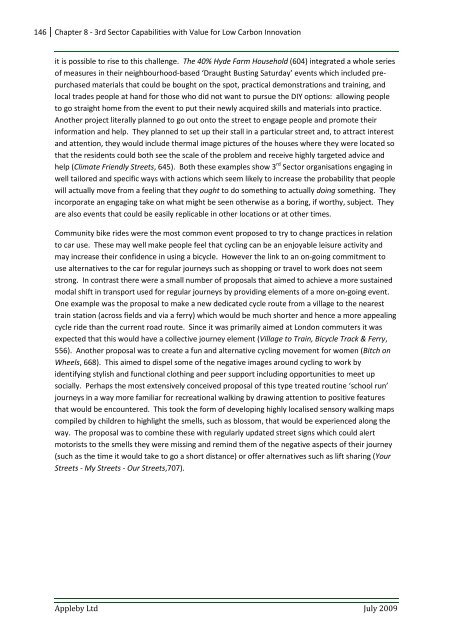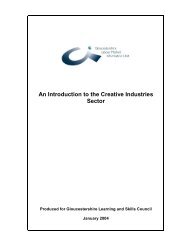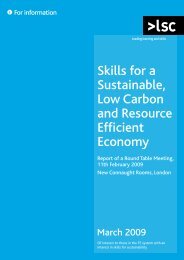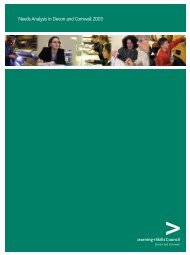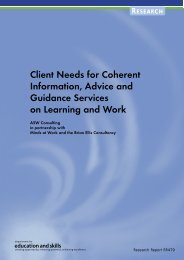Mapping the Big Green Challenge - The Skills & Learning ...
Mapping the Big Green Challenge - The Skills & Learning ...
Mapping the Big Green Challenge - The Skills & Learning ...
You also want an ePaper? Increase the reach of your titles
YUMPU automatically turns print PDFs into web optimized ePapers that Google loves.
146 Chapter 8 - 3rd Sector Capabilities with Value for Low Carbon Innovationit is possible to rise to this challenge. <strong>The</strong> 40% Hyde Farm Household (604) integrated a whole seriesof measures in <strong>the</strong>ir neighbourhood-based ‘Draught Busting Saturday’ events which included prepurchasedmaterials that could be bought on <strong>the</strong> spot, practical demonstrations and training, andlocal trades people at hand for those who did not want to pursue <strong>the</strong> DIY options: allowing peopleto go straight home from <strong>the</strong> event to put <strong>the</strong>ir newly acquired skills and materials into practice.Ano<strong>the</strong>r project literally planned to go out onto <strong>the</strong> street to engage people and promote <strong>the</strong>irinformation and help. <strong>The</strong>y planned to set up <strong>the</strong>ir stall in a particular street and, to attract interestand attention, <strong>the</strong>y would include <strong>the</strong>rmal image pictures of <strong>the</strong> houses where <strong>the</strong>y were located sothat <strong>the</strong> residents could both see <strong>the</strong> scale of <strong>the</strong> problem and receive highly targeted advice andhelp (Climate Friendly Streets, 645). Both <strong>the</strong>se examples show 3 rd Sector organisations engaging inwell tailored and specific ways with actions which seem likely to increase <strong>the</strong> probability that peoplewill actually move from a feeling that <strong>the</strong>y ought to do something to actually doing something. <strong>The</strong>yincorporate an engaging take on what might be seen o<strong>the</strong>rwise as a boring, if worthy, subject. <strong>The</strong>yare also events that could be easily replicable in o<strong>the</strong>r locations or at o<strong>the</strong>r times.Community bike rides were <strong>the</strong> most common event proposed to try to change practices in relationto car use. <strong>The</strong>se may well make people feel that cycling can be an enjoyable leisure activity andmay increase <strong>the</strong>ir confidence in using a bicycle. However <strong>the</strong> link to an on-going commitment touse alternatives to <strong>the</strong> car for regular journeys such as shopping or travel to work does not seemstrong. In contrast <strong>the</strong>re were a small number of proposals that aimed to achieve a more sustainedmodal shift in transport used for regular journeys by providing elements of a more on-going event.One example was <strong>the</strong> proposal to make a new dedicated cycle route from a village to <strong>the</strong> nearesttrain station (across fields and via a ferry) which would be much shorter and hence a more appealingcycle ride than <strong>the</strong> current road route. Since it was primarily aimed at London commuters it wasexpected that this would have a collective journey element (Village to Train, Bicycle Track & Ferry,556). Ano<strong>the</strong>r proposal was to create a fun and alternative cycling movement for women (Bitch onWheels, 668). This aimed to dispel some of <strong>the</strong> negative images around cycling to work byidentifying stylish and functional clothing and peer support including opportunities to meet upsocially. Perhaps <strong>the</strong> most extensively conceived proposal of this type treated routine ‘school run’journeys in a way more familiar for recreational walking by drawing attention to positive featuresthat would be encountered. This took <strong>the</strong> form of developing highly localised sensory walking mapscompiled by children to highlight <strong>the</strong> smells, such as blossom, that would be experienced along <strong>the</strong>way. <strong>The</strong> proposal was to combine <strong>the</strong>se with regularly updated street signs which could alertmotorists to <strong>the</strong> smells <strong>the</strong>y were missing and remind <strong>the</strong>m of <strong>the</strong> negative aspects of <strong>the</strong>ir journey(such as <strong>the</strong> time it would take to go a short distance) or offer alternatives such as lift sharing (YourStreets - My Streets - Our Streets,707).Appleby Ltd July 2009


